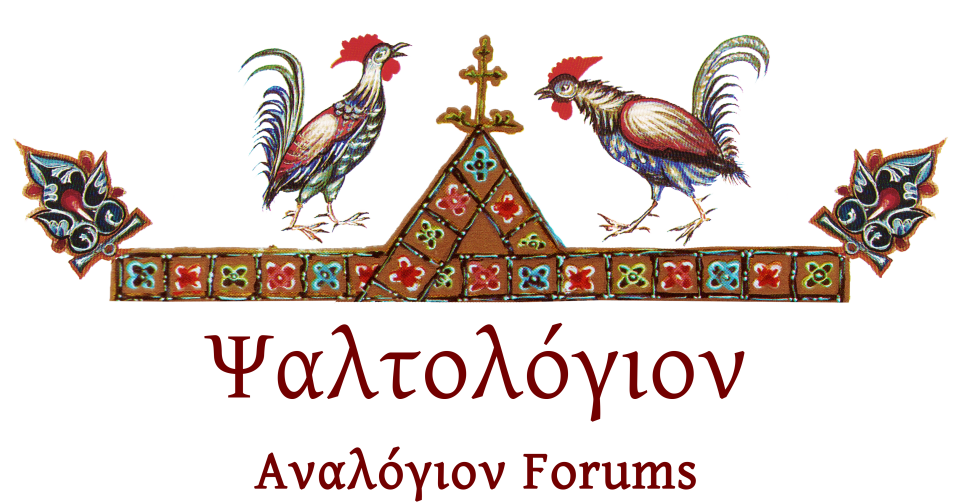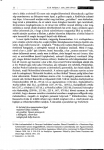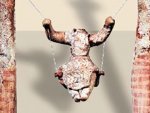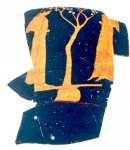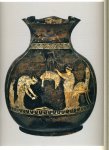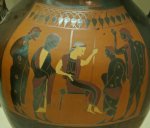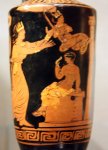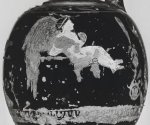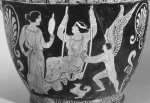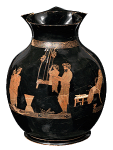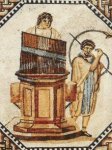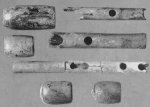εώρα
αλήτις, θηλ. του αλήτης. 1. Τραγούδι που το τραγουδούσαν πάνω σε κρεμαστή κούνια (αιώρα), καθώς κουνιόνταν. Πολυδ. (IV, 55): "Ήν δε και αλήτις άσμα ταις αιώραις προσαδόμενον". Πιστευόταν ότι ήταν τραγούδι της Ηριγόνης (βλ. σημ. πιο κάτω)· Αθήν. ΙΔ', 618Ε, 10: "υπήρχε επίσης ένα τραγούδι που το τραγουδούσαν στη γιορτή της αιώρας, στη μνήμη της Ηριγόνης, και λεγόταν αλήτις".
2. Αλήτις ονομαζόταν επίσης μια γιορτή στην Αθήνα. Ησ.: "Αλήτις, εορτή Αθήνησιν, η νυν Εώρα λεγομένη, και ημέρας όνομα, ως ο Πλάτων ο Κωμικός". Από αυτό φαίνεται πως έτσι (εώρα) ήταν και το όνομα της μέρας της γιορτής.
Σημείωση: Ηριγόνη ήταν η κόρη του Αθηναίου ήρωα Ικάριου, στον οποίο δίδαξε ο Διόνυσος την καλλιέργεια των αμπελιών και την παραγωγή του κρασιού. Η Ηριγόνη γέννησε από τον Διόνυσο έναν γιό, τον Στάφυλο. Ο πατέρας της πρόσφερε από το κρασί του σε μερικούς βοσκούς, που μέθυσαν, και νομίζοντας πως τους δηλητηρίασε σκότωσαν τον Ικάριο. Η Ηριγόνη, με τη βοήθεια του κυνηγετικού σκυλιού του πατέρα της Μάιρα, βρήκε το πτώμα και απελπισμένη για το χαμό του πατέρα της κρεμάστηκε· πριν πεθάνει όμως καταράστηκε τις παρθένες της Αττικής να κρεμιούνται κι αυτές. Πραγματικά αυτό, κατά το μύθο, άρχισε να συμβαίνει, και οι Αθηναίοι ζήτησαν χρησμό από το μαντείο. Με τη συμβουλή του καθιέρωσαν γιορτή προς τιμήν της Ηριγόνης, κατά την οποία τα κορίτσια κρεμούσαν αιώρες και καθώς κουνιόνταν τραγουδούσαν το τραγούδι αλήτις.
Βλ., ανάμεσα σε άλλα, Νόνν. Διον. 48, 34 κ.ε. Επίσης, Γεώργιος Κ. Σπυριδάκης, "Περί της κατά το έαρ αιώρας εις τον Ελληνικόν και τους λοιπούς λαούς της Χερσονήσου του Αίμου", Επετηρίς του Κέντρου Ερεύνης της Ελληνικής Λαογραφίας, KB', 1969-1972, Αθήναι 1973, σσ. 113-130· με μια περίληψη στα γαλλικά, σσ. 131-134. Στη μελέτη αυτή, γίνεται αναφορά αρκετά λεπτομερειακή και στην "αιώρα" στην αρχαία Ελλάδα, σ. 121 κ.ε. (στη γαλλική περίληψη, σσ. 132-133).
~~~~
"Την άμεση σχέση του παιχνιδιού με τη λατρεία του Διονύσου δηλώνει μια σκηνή σ'έναν ωραίο αττικό σκύφο, που βρέθηκε το 1846 στο Τσιούζι και σήμερα βρίσκεται στο μουσείο του Βερολίνου. Ένας στεφανωμένος Σάτυρος, πιστός ακόλουθος του Διονύσου, στέκεται πίσω απο μιάν αιώρα, στην οποία κάθεται μιά νέα και της δίνει ώθηση. Ο σάτυρος που σπρώχνει την κούνια, σημαδεύει το βακχικό χαρακτήρα της γιορτής, όπως σε πολλές άλλες ανάλογες παραστάσεις. Τα κορδονάκια που είναι τυλιγμένα στο κεφάλι του, καθώς και τα φύλλα που σχηματίζουν ακτινωτό στεφάνι είναι θρησκευτικά σύμβολα, μας λέει ο Hunziker. Πάνω απο τη νέα που αιωρίζεται διαβάζουμε τη λέξη ΑΛΗ, που είναι η αρχή της λέξης ΑΛΗΤΙΣ, η οποία ταυτίζεται με την Ηριγόνη, και της οποίας το όνομα έχει τελετουργική σημασία.''
Απολλόδωρος, βιβλιοθήκη, Γ' 14,7
Αθηναίος, Δειπνοσοφιστές ΙΔ' , 10
Πολυδεύκης, Ονομαστικόν, Δ, 7,55
http://www.musipedia.gr/
Aristotelis Opera, Τόμος 10 Από τον Aristotle,Friedrich Sylburg,Karl Friedrich Neumann
http://books.google.gr/books?pg=PA3...lt&id=MNM9AAAAYAAJ&ots=SUABUb1Ek-&output=text
Αθήν. ΙΔ', 618Ε, 10
"υπήρχε επίσης ένα τραγούδι που το τραγουδούσαν στη γιορτή της αιώρας, στη μνήμη της Ηριγόνης, και λεγόταν αλήτις".
ἦν
δὲ καὶ ἐπὶ ταῖς ἐώραις τις ἐπ΄ Ἠριγόνῃ, ἣν καὶ ἀλῆτιν
λέγουσιν, ᾠδή. Ἀριστοτέλης γοῦν ἐν τῇ Κολοφωνίων
Πολιτείᾳ φησίν· ’ἀπέθανεν δὲ καὶ αὐτὸς
ὁ Θεόδωρος ὕστερον βιαίῳ θανάτῳ. λέγεται δὲ γενέσθαι τρυφῶν τις,
ὡς ἐκ τῆς ποιήσεως δῆλόν ἐστιν.
ἔτι γὰρ καὶ νῦν αἱ γυναῖκες ᾄδουσιν αὐτοῦ μέλη περὶ
τὰς ἐώρας.
http://www.sflt.ucl.ac.be/files/AClassFTP/Textes/ATHENEE/deipnosophistes_14.txt
ἀλήτ-ης [α^], ον, Dor. ἀλάτας , α, ὁ; voc.
[...] name of song in honour of Erigone, Ath.14.618e, Poll.4.55, Hsch.s.v.; cf. “ἐώρα” 11.
http://www.perseus.tufts.edu/hopper...1999.04.0057:entry=a)lh/ths&highlight=erigone
~~~~~~~~~~~~~
ἐώρα ,
A. [select] v. αἰώρα, cf. Ael.Dion.Fr.23: pl., of a festival in honour of Erigone, Arist.Fr.515 (αἰ- codd.). ἐωρέω , = αἰωρέω, prob. in S. OC1084 (lyr.), cf. Hsch., Dosith.p.431 K. ἐώρημα , = αἰώρημα, Sch.Ar.Pax77. ἐωρίζεται: μετεωρίζεται, ἀναπατεῖ, Hsch.
Henry George Liddell. Robert Scott. A Greek-English Lexicon. revised and augmented throughout by. Sir Henry Stuart Jones. with the assistance of. Roderick McKenzie. Oxford. Clarendon Press. 1940
http://www.perseus.tufts.edu/hopper... Religion and its survival in Greek Religion, ed. 2, Lund 1950, s. 331-32, note 7.
books.google.gr/books?isbn=0819602736
Martin Persson Nilsson - 1950
[Martin P. Nilsson, "Die Anthesterion und die Aiora," Eranos 15 (1915)181-200.]
O L. Deubner (Attiche Feste, Hildesheim 1966, fvt. anat.) σ. 121 συμ. 4, έχων υπ΄ όψιν την γνώμην ταύτην του Μ. Nilsson ως και την του Wilamowitz ( Der Galube der Hellenen 1, 260, συμ. 4) επι του θέματος, αμφιβάλλει περί υπάρξεως τελετουργικής αιώρας εις τους Μινωικούς χρόνους, νομίζει δε ότι έχουμεν εις την παράστασιν ταύτην απλήν διασκέδασιν.
Την άποψιν ταύτην διετύπωσε πρώτος ο A. Evans (σ. 27) χορίς να επιμείνει εις αυτήν, δεχθείς έτσι την παράστασιν ως εικονίζουσαν έθιμον τελετουργικόν.
Από τους κατόπιν χρόνους της ελληνικής αρχαιότητος γνωρίζομεν περί της υπάρξεως της αιώρας εις τον ιωνικόν κόσμον, αναφερομένης εις Κολοφώνα και εις Αθήνας. 2
Εις την τελευταίαν πόλιν ετελείτο κατά τα Ανθεστήρια αιώρησις των νεανίδων με συμμετοχήν εις αυτίν νέων και με συνοδείαν άσματος που εκαλείτο αλήτις 3, ανηρτωντο δ΄ έτι εις τα δένδρα πρός αιώρισιν και πλαγγόνες. 4
2 Αθήν. 618 ε - φ. Πολυδ., Ονομ. 4, 55. Πρβλ. και Μ. Νilsson, Die Anthesterien und die Aiora. Eranos 15, 1916, 181 εξ., 1999 = Opuscula Ι, Lund 1951, σελ. 145. εξ., 165.
“‘ Δήμητρα ὁτὲ μὲν Χλόην, ὁτὲ δὲ Ἰουλώ. ἀπὸ τῶν οὖν τῆς Δήμητρος εὑρημάτων τούς τε καρποὺς καὶ τοὺς ὕμνους τοὺς εἰς τὴν θεὸν οὔλους καλοῦσι καὶ ἰούλους.’ δημήτρουλοι καὶ καλλίουλοι. καὶ
Αθήν. 618 e-f
πλεῖστον οὖλον οὖλον ἵει, ἴουλον ἵει.
ἄλλοι δέ φασιν ἐριουργῶν εἶναι τὴν ᾠδήν. αἱ δὲ τῶν τιτθευουσῶν ᾠδαὶ καταβαυκαλήσεις ὀνομάζονται, ἦν δὲ καὶ ἐπὶ ταῖς ἐώραις τις ἐπ᾽ Ἠριγόνῃ, ἣν καὶ ἀλῆτιν λέγουσιν, ᾠδή. Ἀριστοτέλης γοῦν ἐν τῇ Κολοφωνίων Πολιτείᾳ φησίν ‘ ἀπέθανεν δὲ καὶ αὐτὸς ὁ Θεόδωρος ὕστερον βιαίῳ θανάτῳ. ’”
Athenaeus. The Deipnosophists. with an English Translation by. Charles Burton Gulick. Cambridge, MA. Harvard University Press. London. William Heinemann Ltd. 1927. 1.
http://www.perseus.tufts.edu/hopper/text?doc=Perseus:text:2008.01.0405:casaubonpage=618e
~~~~~~~~~~~~
Oinoche_Anthesteria.jpg
sfrang.blogspot.com
~~~~~
Woman on a swing. Side B of an Ancient Greek Attic red-figure amphora, ca. 525 BC. from Vulci, Italy. Louvre Museum, Paris.
Read more:
http://www.answers.com/topic/swing#ixzz2D3HPWb1p
~~~~~
A Rite of Swinging during the Anthesteria - JStorwww.jstor.org/stable/4475147 B. C. DIETRICH. A RITE OF SWINGING DURING THE ANTHESTERIA. The purpose of this paper is to investigate the relationship of the Aiora to the Anthesteria.
http://www.jstor.org/discover/10.23...=3&uid=29736&uid=67&uid=62&sid=21101407581221
~~~~~~~
A Figurine from Aghia-Triada and the Day of Aiora in Athensmore
by Elena Chepel
"In this paper the author analyzes written and iconographic evidence for the day of Aiora and argues for the sexual meaning of female swinging in Ancient Greece by tracing the genetic affi nity of the Attic rite of swinging with a... more
"In this paper the author analyzes written and iconographic evidence for the day
of Aiora and argues for the sexual meaning of female swinging in Ancient Greece by
tracing the genetic affi nity of the Attic rite of swinging with a Minoan ritual fi gurine
found in Aghia-Triada."
http://www.academia.edu/337947/A_Figurine_from_Aghia-Triada_and_the_Day_of_Aiora_in_Athens
~~~~
Descriptive depiction of the Aiora h Vrachionios, known today as a see-saw.
From a red-figure Attic vessel, 5th cent. B.C.
~~~~~~
Descriptive depiction of the Aiora h Vrachionios, known today as a see-saw.
From a red-figure Attic vessel, 5th cent. B.C.
~~~~~~~~
Goddess, the Classical Mode, Harold Koda, the Metropolitan Museum of Art...p180
"The figures in this vase painting are thought to be preparing for a civic festival in celebration of the dead. Because they are in the act of perfuming garments for the event, the delineation of the garment pieces is particularly detailed. A woman in a finely pleated chiton and band-bordered himation on the right gestures toward another woman accompanied by a child. Bent over to pour fragrance into a bundle of cloth, the woman on the left wears a linen chiton and a short overtunic, not unlike the astrochiton associated with Artemis. While the astrochiton was covered with a pattern of stars, in this garment zones of pictographs alternate with Greek-key bands. A swing at center is stacked with neatly folded garments, with the border of the uppermost garment also patterned with the Greek key. Likewise, a klismos chair is piled with what appear to be a pleated chiton and another astrochiton with pictographs, Greek-key borders and an edge of palmette motifs. The ubiquity of the Greek key in textile patterns is also evidenced the the headscarves of both women."
I copied this this picture with it's text because of a wiki I have in the older Demeter, Persephone, Triptolemos relief that mentions coating a baby with "ambrosia" which to my mind suggests the scented oil of anointment
As a gift to Celeus, because of his hospitality, Demeter planned to make Demophon (a name for Triptolemos's brother) as a god, by coating and anointing him with ambrosia, breathing gently upon him while holding him in her arms and bosom, and making him immortal by burning his mortal spirit away on the family hearth every night."
I probably go to far equating this ambrosial rub with the scented oil, I'm probably going to far in comparing the ritual garments woven for the image of Athena to wear during her processions in Athens with the weavings made for the asherah on the temple mount in Jerusalem and other high places of Judea. 2 Kings 23;7 And he brake down the houses of the sodomites, that [were] by the house of the LORD, where the women wove hangings for the grove.
The term Greek key is equivalent to the terms "meander" and "fret" used to describe "the repeated decorative border constructed from a continuous line, shaped into a repeated motif." seen in many cultures. I wondered about the "key" part of this term and how it might relate to the temple key [[priestess]] saus were carried by priestesses in procession to the temple on festival day. (They torment me most every day with a throat clearer and have for years---decades of years. throat clear. although there are days when there are breaks, even long breaks, of most days it would have to be said that the torment continued all day. Today, the throat clearer was here when I got back from eating and warming up outside. [I mentioned a couple days ago that I like to press my cold hands against the warm metal of the handrails and the flat surfaces of the concrete. Once I get my body temperature back up, that doesn't work anymore as those surfaces are too hot to comfortably touch. I think I forgot to mention in that long piece about air conditioning that every summer for more than 15 years they have run the refrigeration unit all night every night and since it is running in the morning when I leave and in the evening when I return, I assume it runs all day also. I think it was installed around the time my sister tormented by having one installed in Holaday. I still want to get back and add these to that page.] He a huge middle age male with straight brown hair parted almost down the middle in what I would have identified as a beta style in the sixties. I haven been able to look at him but I'm imagining [A middle age female just cruised me with a cruelly placed catbird smile. She has long, healthy gray hair brushed out in a style I often think belongs to a girls dressed in short and frayed cut of Levis. I don't really know why it was so disturbing to me that she directed the smile at me as though we had some mutual insight into things. She's sitting over there reading this now as I insert it in the text I was working on at the time she cruised by. My hands are beginning to tremble a little and to feel cold although I think they haven't turned the air as low as usual. In such a context I always feel like insulting them in my descriptions. I just looked over at her hair and its not really brushed and styled in the way I had imagined although I still feel that wearing the hair down is a style for younger females such as the one they have had at the bus stop this morning.) him with acne scars on a pleasantly form face. I think he has a large pot belly and whenever I glance lately he he's looking into a throat clear book with a wide, close-lipped catbird smile. As I came to these "Greek-key" motiffs, the large librarian male with hiply swept back, curly, mostly black, salt and pepper hair who plays in the blue grass band with the concertina player who could be related to Uraesus? Japanese chauffeur came to the same shelf I mentioned him coming to the other week and pointing to the card as he gave throat clear elementary instructions as their use. Today, he actually throat clear followed by an incoherent vocalization pinched the card between the thumb and first three fingers of his left hand as he jabbed at the throat clear library of congress numbers and explained (a happy happy heterosexual couple yawn just came by and joyfully greeted the bit older than student age male with the stubble beard and now are talking to him in maybe Spanish or Portuguese. I can't really hear. The male just broke the train of conversation by saying "no" to me in unaccented American English. He Is about the same coloring as the and could be his brother. He has a hairline that is so far receded I might as will call him bald. throat clear from behind and heh heh heh as their conversation becomes a cheerful din. The muscles under my nose are becoming spastic. The female has shoulder length, straight black hair parted on one side a brushed to stiffly frame her face without bangs. She has about the same coloring as her companion but his hair is curly and cut in a butch. In a friendly conversation I might say she looks Hispanic or maybe even Mexican. When they first arrived, she met one or two my glances by tightening her face and pushing her tongue against her closed lips in a wry look that seems expectant of some tearful or angry emotional response to the pain she knows she is inflicting by it. It's a look Diane often uses as she drops a flash fuse or whatever. As she did she started moving one knee in and out against the other or making some similar movement with her throat clear legs causing her head to wag in quick rhythm to the spiritous mood of her facial expression. The throat clear even has on calf length white socks with two throat clear colored bands at the top to go with his white tenny runners and bermuda shorts. hmmm no i hate him in a male! voice They've been punctuating me all day. All but him throat clear have gone. He holds his stony catbird smile up to each of my glances and often he punctuates a throat clear by noisily turning a page.) in minute detail their cosmic purpose to the two dark complected, bare legged, fairly shapely student age? females who enthusiastically accompanied him. They both had shoulder length or longer, straight black hair and throat clear I'm almost certain that one of them was the young looking student age female who gave me the beaver shot as I spoke with the Harward male "security guard" who, incidentally, was at the bookstore "snack shop" today apparently playing the role of one of 3 or 4 other counter clerks there today. I can't imagine why. I think I've mentioned that I've seen here a few times during the last couple weeks and the "young looking" characterization was accurate. I thought at that time I might be seeing two of them and today confirmed it since these two were about the same coloring although when they returned alone sometime after disappearing into the stacks with [[]], I noticed the one is a taller and much older young looking. In fact I considered that she could be the other's mother. Her catbird smile as the passed had an almost embarrassed defiance. I'm not sure, but I think she may have had some pimpling on one cheek and I thought she looked kind of Mexican indigena while I thought both look Greek to me as they arrived with [[]] and I was imagining him to be their Greek father at the very time I was trying to decide throat clear the the long time gargoyle with the hair a little to short to stay in the ponytail he ties it in just strode by how to work [[Ex 28 34 A golden bell and a pomegranate, a golden bell and a pomegranate, upon the hem of the robe round about. ]] into the thought of the relationship between pomus fruit tree and pompa, sacred procession (The bit older than student age negro...just cruised me in a golf shirt and when he got the 20 or so yards to the corner he coughed back at me) and the decorative motif some call Greek key.
http://www.flickr.com/photos/11787607@N02/7791032408/
~~~~~~~~~
Two-handled jar (amphora) depicting a woman in a swing and four men. Greek, Archaic Period, about 540–520 B.C. The Swing Painter. Attic ceramic (black figure). Museum of Fine Arts, Boston.
http://www.flickr.com/photos/sebastiagiralt/3136368496/
~~~~~~~~
http://www.flickr.com/photos/peterjr1961/5176907883/
Terracotta lekythos (oil flask)
Terracotta lekythos (oil flask)
Red-figure; Greek, South Italian, Apulian; Late Classical; ca. 375–350 B.C.
Associated in style with the Lecce Painter
Woman pushing girl on a swing, youth sitting on an altar, and Hermes
The Aiora and Anthesteria, Athenian festivals dedicated to Dionysos, god of wine, included girls swinging. The Hermaia, celebrating Hermes, the messenger god, featured athletes; the youth here holds a strigil (scraper), and Hermes himself stands by a column suggesting a sacred precinct. The Athenian festivals may have had Apulian counterparts.
~~~~~~
EO΄RA
AEO΄RA or EO΄RA (αἰώρα, ἐώρα).
1. A festival at Athens, accompanied with sacrifices and banquets, whence it is sometimes calledεὔδειπνος. The common account of its origin is as follows:--Icarius was killed by the shepherds to whom he had given wine, and who, being unacquainted with the effects of this beverage, fancied in their intoxication that he had given them poison. Erigone, his daughter, guided by a faithful dog, discovered the corpse of her father, whom she had sought a long time in vain; and, praying to the gods that all Athenian maidens might perish in the same manner, hung herself. After this occurrence, many Athenian women actually hung themselves, apparently without any motive whatever; and when the oracle was consulted respecting it, the answer was that Icarius and Erigone must be propitiated by a festival (Hygin. Poet. Astron.2.4). According to the Etymologicum Magnum, the festival was celebrated in honour of Erigone, daughter of Aegisthus and Clytaemnestra, who came to Athens to bring the charge of matricide against Orestes before the Areiopagus; and, when he was acquitted, hung herself, with the same wish as the daughter of Icarius, and with the same consequences. According to Hesychius, the festival was celebrated in commemoration of the tyrant Temaleus, but no reason is assigned. Eustathius (ad Hom. pp. 339, 1535) calls the maiden who hung herself Aiora. But as the festival is also called Ἀλῆτις (apparently from the wanderings of Erigone, the daughter of Icarius), the legend which was first mentioned seems to be the most entitled to belief. Pollux (4.7.55) mentions a song made by Theodorus of Colophon, which persons used to sing whilst swinging themselves (ἐν ταῖςαἰώραις). It is, therefore, probable that the Athenian maidens, in remembrance of Erigone and the other Athenian women who had hung themselves, swung themselves during this festival, at the same time singing the above-mentioned song of Theodorus. (SeeAthen. 14.618; Schömann, Griech. Alterth. vol. ii. p. 434.) [L.S]
2. A swing, which formed a favourite amusement in Greece, as in England at the present day (cf. Suidas, s.v. Zonaras, s.v. Paus. 10.29). The following cut shows a group swinging one another. [J.H.O]
Aeora, or Swing, from Panofka.
A Dictionary of Greek and Roman Antiquities. William Smith, LLD. William Wayte. G. E. Marindin. Albemarle Street, London. John Murray. 1890.
http://www.perseus.tufts.edu/hopper...habetic+letter=A:entry+group=3:entry=aeora-cn
~~~~~~~~~~~
Halbherr, F. 1903. "Resti dell'età micenea scoperti ad Haghia Triada presso Phaistos" Monumenti Antichi 14:74, figs. 42, 43.
Richter, Gisela M.A. 1922. "Cretan Reproductions." Bulletin of the Metropolitan Museum of Art 17(3): p. 62.
Richter, G.M.A. 1927. Handbook of the Classical Collection. New York: The Gilliss Press, 34.
Evans, A.J. 1935. Palace of Minos at Knossos. Vol. 4, pt. 1. London: Macmillan and Co., 24-7, fig. 13.
Zervos, C. 1956. L'Art de la Crete Neolithique et Minoenne. Paris: Editions "Cahiers d'Art, fig. 578.
http://www.metmuseum.org/Collections/search-the-collections/130018835
~~~~~~~~~~~
Erigone's story is told in various ways in the sources, but she is generally associated with the Athenian Anthesteria and specifically with the Aiora, the ritual swinging that takes place at one point during the larger festival. The young girls of Athens must swing in the trees during this rite to placate the spirit of Erigone Aletis, the wandering one, who hangs herself from a tree after the death of her father.[35] Either Erigone is the daughter of Klytemnestra and Aigisthos, who wanders into Attica in vengeful pursuit of Orestes and kills herself after he is acquitted,[36] or she is the daughter of the local farmer Ikarios, to whom Dionysos first introduces wine and viticulture. When Ikarios gives wine to his neighbors, they kill him in a drunken fury and hide his body when they wake up with the first hangover. When she cannot find her father, Erigone wanders around seeking him, finally hanging herself when she discovers his corpse.[37] As Johnston has pointed out, whether Erigone is described as the daughter of Ikarios or of Aigisthos, in both cases the death of her father means that she has no one to arrange her marriage and facilitate her transition to adult womanhood.[38] Nonnos' version (47.185-6) even has the bloody ghost of her father appear to her and specifically lament that she will never know marriage.
This death of a maiden in the disrupted transition to adulthood naturally stains the community with the miasma of her untimely death, and the maidens of Athens are afflicted with a violent impulse to end their own lives in the same fashion until an oracle ordains the festival of the Aiora as way of averting the anger of Erigone.[39] The festival includes the girls' swinging that is so cheerfully depicted in vase paintings, as well as the Ἀλῆτις song, no doubt a choral song and dance honoring the maiden, performed by the maidens who wish to avoid the grief she suffered by providing a recompense in ritual.[40]
In Laconia, the Caryatis chorus is performed by maidens in honor of the unfortunate Carya, who, seduced by Dionysos, never completed her transition to adulthood but was transformed into a tree. Lactantius (ad Statius Thebaid 4.25) tells how the local maidens went mad and hung themselves from the branches of this carya tree. The temple of Diana Caryatis was founded on that spot, and presumably the Caryatis festival celebrated there arose at that time. As Johnston suggests, the rite serves to appease the maiden, who was stranded in a liminal zone, betwixt and between being a maiden and a woman, living and dead.[41] The grief of Carya is appeased by the ritual honors so that the maidens of Laconia do not suffer the same grief of disrupted transition to adult life.
The threat of the maiden's anger if unappeased appears explicitly in the cases of Erigone and Carya, but the same pattern appears, albeit without the explicit threat, in the case of the Proetid Iphinoë. Hesychius defines the Agriania festival as one celebrated for one of the daughters of Proitos, but also as a festival of the dead.[42] Like the Anthesteria in Athens, the Agriania involved the appeasement of the spirits of the dead to ensure the fertility of the community in the coming year. Just as the appeasement of Erigone by ritual choruses of maidens seems to have been part of the Anthesteria to make sure that the maidens of Athens would be able to complete their transitions to mature womanhood, marriage and childbearing, so at the Agriania Iphinoë may have been honored. Whereas the other daughters of Proitos who went wild and wandered like cows in the hills were tamed and married off to Melampous and his brother, Iphinoë perished in the process, attaining death instead of marriage.[43] Pausanias tells us that maidens in Megara on the brink of marriage made libations and offerings of their hair to Iphinoë, here the daughter of the local hero Alkathoos, since she died before marriage, like the Hyperborean maidens at Delos.[44] The Agriania may have involved other kinds of rituals, since Pausanias and Apollodorus tell us that Melampous cured the girls with certain rites, purifications and choruses that involved the youths as well as the maidens.[45] To judge by the parallel of the Anthesteria, the festival must have been concerned with the renewal of the fertility of the community through the appeasing and honoring of the powers of the dead, both collectively and as individuals like Iphinoë concerned with particular aspects.
The associations of Melampous with Dionysiac rites, as well as the mention of ecstatic dancing and purificatory καθαρμοί, recall the presence of Dionysos in the other tales. In each case, Dionysos appears as a disruptive force who disturbs the maiden's expected path of transition from girl to wife. The Proetids' maiden madness is caused and/or cured by his power, and he seduces Carya and, in some versions, Erigone as well. While neither of these maidens end up, like Ariadne, as the official bride of the god, it is worth noting the variants of Ariadne's story that conclude with her disrupted transition to marriage ending with suicide by hanging, like Erigone.[46] Johnston has indeed pointed out that, in this pattern of girl's transition, the positive and negative endings are two sides of the same coin.[47] Instead of having a normal transition into the adult roles of wife and mother by which they gain a new status in the human community, these mythic maidens suffer extraordinary experiences and never obtain a normal adult life. Some maidens end up dead, exerting power as vengeful spirits that threaten other maidens, whereas others end up divinized in some way, as cult statues, priestesses, or even brides of a god.
35] Etymologicum Magnum 42.4 Αἰώρα: Ἑορτὴ Ἀθηναῖς, ἣν καλοῦσιν εὔδειπνον. Λέγεται γὰρ Ἠριγόνην τὴν Αἰγίσθου καὶ Κλυταιμνήστρας θυγατέρα σὺν Τυνδαρέῳ [τῷ πάππῳ] ἐλθεῖν Ἀθήναζε, κατηγορήσουσαν Ὀρέστου· ἀπολυθέντος δὲ, ἀναρτήσασαν ἑαυτὴν, προστρόπαιον τοῖς Ἀθηναίοις γενέσθαι· κατὰ χρησμὸν δὲ ἐπ’ αὐτῇ συντελεῖσθαι τὴν ἑορτήν. Aiora: A festival for the Athenians, which they call a feast offered to departed souls. For they say that Erigone, daughter of Aigisthos and Klytmenestra came with her grandfather Tyndareus to Athens to prosecute Orestes. When he was acquitted, she hung herself and became a cause of pollution for the Athenians. In accordance with an oracle, the festival is performed for her.
Servius ad Verg. Geo. 2.389 sed post aliquantum tempus Atheniensibus morbus immisus est talis, ut eorum virgines quodam furore compellerentur. But after a certain time, a sickness afflicted the Athenians to such an extent that their maidens were driven by some kind of frenzy. Etymologicum Magnum 62.9 Ἀλῆτις: Τινὲς τὴν Ἠριγόνην τὴν Ἰκαρίου θυγατέρα, ὅτι πανταχοῦ ζητοῦσα τὸν πατέρα ἠλᾶτο· οἱ δὲ Αἰγίσθου καὶ Κλυταιμνήστρας φασίν· οἱ δὲ, τὴν τοῦ Μαλεώτου τοῦ Τυρρηνίου θυγατέρα· οἱ δὲ, τὴν Μήδειαν, ὅτι μετὰ τὸν φόνον τῶν παίδων πρὸς Αἰγέα κατέφυγεν ἀλητεύσασα· οἱ δὲ, τὴν Περσεφόνην· διότι τοὺς πυροὺς ἀλοῦντες πέμματα τινὰ προσέφερον αὐτῇ. Aletis: Some say that she is Erigone, the daughter of Ikarios, since she wandered everywhere seeking her father. Others say she is the daughter of Aigisthos and Klytemnestra. Still others say she is the daughter of Maleotos the Tyrrhenian; others that she is Medea, since, having wandered after the murder of her children, she escaped to Aigeus. Others say that she is Persephone, wherefore those grinding the wheat offer some cakes to her.
[36] Erigone, daughter of Clytemnestra and Aegisthus: Marm Par. 40; Apollod. Ep. 6.25; EtMag s.v. Αἰώρα & Ἀλῆτις; Hyg. Fab. 122; Paus. 2.18.6.
[37] Erigone, daughter of Icarius: Apollod. 3.14.7; Aelian NA 7.28; Nonnos 47.148-255; Hesych. s.v Αἰώρα; EtMag s.v. Ἀλῆτις; Hyg. Astr. 2.4; Serv. ad Verg. Geo. 2.389.
http://chs.harvard.edu/wa/pageR?tn=ArticleWrapper&bdc=12&mn=1297#_ftn35
~~~~~~~
Κούκλες κοριτσιών (πλαγγόνες)
Υλικό: Πηλός και μάρμαρο
Προέλευση: Από το τάφο στην Τανάγρα (πλαγγόνα) και την Αθήνα (επιτύμβια στήλη)
Χρονολόγηση: 425-400 π.Χ. (πλαγγόνα) και αρχές 4ου αι. π.Χ. (επιτύμβια στήλη)
Χώρος έκθεσης: πλαγγόνα: Αίθουσα 58, Προθήκη 6, αρ.4752, επιτύμβια στήλη: αρ. 1993
Αγαπημένο παιχνίδι (άθυρμα) των κοριτσιών ήταν οι κούκλες (πλαγγόνες), κατασκευασμένες από κερί, ξύλο, ελεφαντόδοντο και, στην πλειονότητά τους, πηλό. Παρίσταναν κυρίως γυναικείες μορφές με κόμμωση και γραπτή δήλωση ενδυμάτων, αν και μερικές φορές στολίζονταν και με ρούχα από ύφασμα. Οι τεχνίτες αυτών των αντικειμένων ονομάζονταν κοροπλάσται. Επειδή οι αρθρώσεις των ώμων και των μηρών ή των γονάτων, συνδεδεμένες με νήμα ή σύρμα, επέτρεπαν να είναι κινητά τα άκρα, καλούνταν νευρόσπαστα.
Βιβλιογραφία: Μ. Fitta, Spiele und Spielzeug in der Antike. Unterhaltung und Vergnugen im Altertum, Στουτγάρδη 1998, 56-59. Ιωάννα Μεννέγκα, στο Ν. Καλτσάς και A. Shapiro, Γυναικών λατρείες. Τελετουργίες και καθημερινότητα στην κλασική Αθήνα, κατ. έκθεσης Νέα Υόρκη-Αθήνα, Αθήνα 2009, 304-305.
~~~~~~~~~~~
MID10550, Vulci, Germany, München, Staatliche Antikensammlungen und Glyptothek, 2520 (1. Inv.), terracotta, vase painting red figured, 410BC/400BC, swing, Himera, Paidia, Himeros, Himeroi 15, Paidia 7, VI.1.b.Kindheit und Adoleszenz.gr. 67
http://www.iconiclimc.ch/visitors/treesearch.php?source=100&term=swing
~~~~~~~~~~~
MID36219, Southitaly, United kingdom, London, British Museum, F 123 (1. Inv.), terracotta, vase painting red figured, mirror, dog, fillet, taenia, tainia, swing, jewellery, winged figure, Eros, Eros 579, VI.1.b.Kindheit und Adoleszenz.gr. 69
Pottery: red-figured skyphos.
Designs red on black ground, with yellow accessories; coarse style. Above the designs, (a) palmettes, (b) egg-moulding; below, maeander and crosses; under the handles, palmettes.
(a) Phaedra (?): A female figure seated in a swing to left, looking up, with hair in a knot, fillet, earrings, necklace, bracelets, long girt chiton fastened with fibulae on the shoulders, and himation over knees; she holds the rope with both hands. The swing is propelled by Eros from behind; his figure has been much restored; below the swing is a small dog leaping up to left. On the left is a female figure to right, with hair in a knot, earrings, necklace, bracelets, long girt chiton fastened with fibulae on the shoulders, holding up a mirror in left hand. The breasts of the female figures are indicated in white.
Gerhard, Ant. Bildw. pl. 54; Panofka, Griechinnen u. Griechen, plate, fig. 7.
For the subject of side a, cf. Berlin No. 2589; Jahn, Ber. d. Sachs. Gesellsch. 1854, p. 243 ff.; Becq de Fouquieres, Les Jeux des Anciens, p. 54; Daremberg and Saglio, i. p. 171; and Baumeister, p. 1571. According to Pausanias, x. 29, 3, Polygnotos represented Phaedra as swinging in his painting at Delphi (see Robert, Nekyia des Polygnot, p. 57. This scene might also have reference to Erigone, whose death by hanging was commemorated in the Athenian Αίώρα or swinging festival (Harrison and Verrall, p. xlii.).
http://www.britishmuseum.org/resear...h_the_collection_database.aspx¤tPage=20
~~~~~~~~~~~~~~
ELENA CHEPEL
A Figurine from Aghia-Triada and the Day of Aiora in Athens
In this paper the author analyzes written and iconographic evidence for the dayof Aiora and argues for the sexual meaning of female swinging in Ancient Greece bytracing the genetic a
ffinity of the Attic rite of swinging with a Minoan ritual figurine found in Aghia-Triada.
PARIBENI R. Ricerche nel sepolcreto di Haghia Triada // Monumenti Antichi. V. 14, pt. 2, 1905. P.747 ff, figs 42, 43.
PICARD CH. Phèdre “à la balançoire” et le symbolisme des pendaisons // Revue Archéologique. 28,1928. P. 50;
NILSSON M.P. Minoan-Mycenean Religion and its Survival in Greek Religion. Lund, 1927. P.258.
MARINATOS Sp. Αἰώρα// Antichton. 2, 1968. P. 8f
BURKERT W. Greek Religion. New York, 1985. P. 40
EVANS A. Myсenaean Tree and Pillar Cult and its Mediterranean Relations // JHS 21, 1901. P. 106
Etym. Magn. s. v. Αἰώρα, Hesych. Lexicogr. s. v. Αἰώρα
Hesych. Lexicogr. s. v. Ἀλῆτις.
Hygin. Astr. II 4
Etym. Magn. s. v. Ἀλῆτις
Apollod. III 14, 7
Nonn. Dion. XLVII 221-237
Hygin. Fab. 130 ICARIVS ET ERIGONE, Serv. ad Verg. Georg. II 389.
HYGIN. Astr. II 4
Aetia 178, 1-5
ἠὼς οὐδὲ πιθοιγὶς ἐλάνθανεν οὐδ’ ὅτε δούλοις
ἦμαρ ᾿Ορέστειοι λευκὸν ἄγουσι χόες·
᾿Ικαρίου καὶ παιδὸς ἄγων ἐπέτειον ἁγιστύν,
᾿Ατθίσιν οἰκτίστη, σὸν φάος,᾿Ηριγόνη,
ἐ̣ς̣ δ̣α̣ίτη̣ν̣ ἐκ̣άλ̣ε̣σσεν ὁμηθέας…
Ath. Pol. 3, 5.
DEUBNER L. Attischer Frühlingszauber // Festschrift f. P. Clemen, 1926. S. 115-129
H. IMMERWAHR K. Choes and Chytroi // TAPA 77, 1946. P. 245-260
X 29, 3.
...ἔστιν ἐγγυτάτω τοῦ στρέφοντος τὸ καλῴδιον᾿ Αριάδνη· κάθηται μὲν ἐπὶ πέτρας ὁρᾷ δὲ ἐς τὴν
ἀδελφὴν Φαίδραν τό τε ἄλλο αἰωρουμένην σῶμα ἐν σειρᾷ καὶ ταῖς χερσὶν ἀμφοτέραις
ἑκατέρωθεν τῆς σειρᾶς ἐχομένην· παρεῖχε δὲ τὸ σχῆμα καίπερ ἐς τὸ εὐπρεπέστερον
πεποιημένον συμβάλλεσθαι τὰ ἐς τῆς Φαίδρας,τὴν τελευτήν.
PARKER R. Polytheismand society at Athens. NY, 2005. P. 184
NILSSON M. P. Griechische Feste von religiöser Bedeutung. Leipzig, 1906. S. 232ff
Paus. III 19, 10; VIII, 23.
PICARD CH. Phèdre “à la balançoire” et le symbolisme des pendaisons // Revue Archéologique. 28,1928. P. 47-64.
Ovid. Met.VI 125
Beazley Archive Pottery Database 219002
www.beazley.ox.ac.uk
BEAZLEY J. D. Attic Red-Figure Vase-Painters, 2d ed. Oxford, 1963: 1301.7
CorpusVasorum Antiquorum. Berlin. Antikensammlung-Pergamonmuseum, 55-56 T. (146) 35. 1-4.
Paris, Musée du Louvre CA2191. 214983
BEAZLEY J. D. Attic Red-Figure Vase-Painters, 2d ed. Oxford, 1963:1131.173
Corpus Vasorum Antiquorum. Paris, Musée du Louvre 9, III. I. D. 37, Pl.( 365) 50.1-2
Berlin, Antikensammlung, F2394; 214982
BEAZLEY J. D. Attic Red-Figure Vase-Painters, 2d ed. Oxford,1963: 1131.72
Corpus Vasorum Antiquorum. Berlin, Antikensammlung 9, 57-58, Beilage 8.3, T.(3722, 3748) 32.1-5, 58.8
HAM G. L. The Choes and MaleMaturation Ritual in Attic Dionysiac Cult. Texas, 1997. P. 272
Lact. ad Stat.Theb. IV, 225
HOOFF A. J. L. From Autothanasia to Suicide: Self-killing in Classical Antiquity. Routledge, 1990.
GARRISON E. P. Some Contexts of Suicide in Greek Tragedy. Stanford, 1987. P. 4
FONTENROSE J. Python. A Study of Delphic Myth and its Origins. Berkeley and Los Angeles, 1959.P. 380-381.
LORAUX N. Façons tragiques de tuer une femme. Paris, 1985. P. 38
Athen. XIV618е
Her. I 171
Thuc. I 4
http://www.academia.edu/337947/A_Figurine_from_Aghia-Triada_and_the_Day_of_Aiora_in_Athens
~~~~~~~
http://www.beazley.ox.ac.uk/xdb/ASP...Page=Contacts&newwindowsearchclosefrombrowse=
~~~~~~
497, Munich, Antikensammlungen, J234, Munich, Antikensammlungen, 2520
9134, Stuttgart, Wurttembergisches Landesmuseum, 65.1, Luzern, Market, Ars Antiqua, XXXX9134
214982, Berlin, Antikensammlung, F2394, Berlin, Schloss Charlottenburg, F2394
214983, Paris, Musee du Louvre, CA2191
216950, Athens, National Museum, BS319, Athens, National Museum, VS319
219002, Berlin, Antikensammlung, F2589, Berlin, Pergamonmuseum, F2589
Add to photo album
220503, New York (NY), Metropolitan Museum, GR1243, New York (NY), Metropolitan Museum, 75.2.11
301521, Boston (MA), Museum of Fine Arts, 98.918
301554, Paris, Musee du Louvre, F60
350489
~~~~~~~~
ΒΣ 0319
Red figured chous. Anthesteria.
A man prepares to leave a child on a swing. By the Eretria Painter. Probably form Koropi. 435-420 B.C.
http://www.namuseum.gr/collections/vases/classical/classic09-en.html#
~~~~~~
Θυμάμαι τη Σμύρνη / Καρτσωνάκης-Νάκης, Ν. Το Ελληνικό βιβλίο, [1972].
Σχεδίασμα της αιώρας εις την Ιωνίαν
''...κι οι κοπέλλες κάνανε κούνιες. Ηκρεμάγανε με δυο δυνατά σκοινιά σανίδες απ’ τα χοντρά κλωνιά των πλατανιών, ηκαθούντοστε τρεις στη σανίδα, ηστεκούντοστε άλλες δυο όρθιες στση δύο άκρες τση σανίδας και λέμπανε, πότε η μια γονάτιζε λίγο και πότε η άλλη ησηκονούντανε κι έτσι ηδίνανε κίνηση και παλμό στση κούνιες. Από κάτω ένα δύο νεαροί ησπρώχνανε τη σανίδα με τα χέρια τους όταν αυτή ηρχούντανε κοντά τους για να τση δώσουνε φόρα. Ήχανε και το πονηρό στο νου τους μήπως δούνε τίποτε κάτω από τα φουστάνια των κοριτσιών που ανεμίζανε.''
